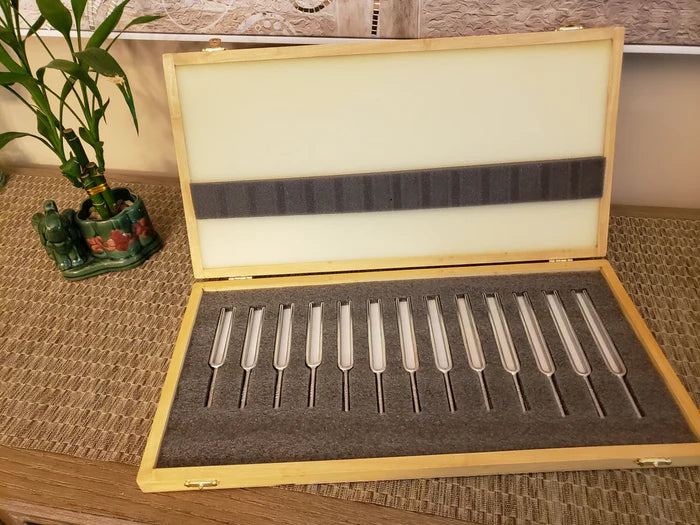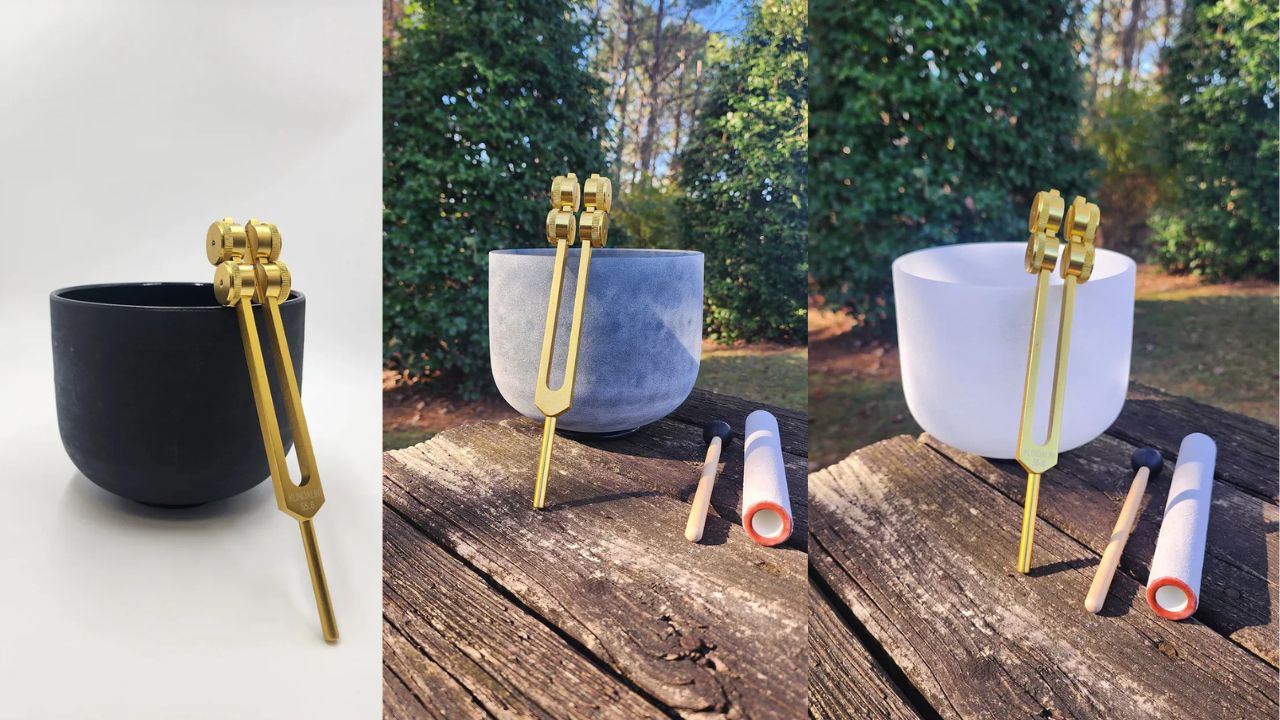Curious about how to use tuning forks and their powerful healing potential? Whether you're seeking relaxation, enhancing your meditation, or tuning musical instruments, mastering the art of using a tuning fork can open up a world of benefits. In this guide, we'll explore step-by-step how to use tuning forks effectively for various purposes, from sound therapy to mindfulness practices. Let's dive into this fascinating journey of sound and healing!
How To Use Tuning Fork?
Using a tuning fork can be a simple yet powerful way to tap into the benefits of sound. Whether for sound therapy, relaxation, or tuning instruments, follow these easy steps to get started:
Choose the Right Tuning Fork
Select a tuning fork based on your intention. For sound therapy, you might choose a specific frequency (e.g., 528Hz for healing or 432Hz for relaxation). For tuning musical instruments, opt for a fork tuned to the desired pitch (such as A440 for standard tuning).
Activate the Tuning Fork
Hold the tuning fork firmly by its stem and gently strike it against a soft surface, like a rubber mat or the palm of your hand. This creates a vibration that produces a clear, resonant tone.
Listen to the Sound
After striking the fork, listen carefully to the sound. The tone should be clear and sustained for several seconds. Pay attention to the vibrations as they resonate in the air and your surroundings.
Apply the Tuning Fork for Therapy
For therapeutic use, hold the stem of the tuning fork near the body or specific areas that need attention (like your temples, wrists, or chakras). Let the vibrations flow through the body. You can also place the stem on a surface like a table to amplify the sound.
Use the Tuning Fork for Meditation
Incorporate the sound into meditation by focusing on the tone and its vibrations. Allow the sound to deepen your state of relaxation and help clear mental blockages.
Care for Your Tuning Fork
After use, gently wipe your tuning fork with a soft cloth to remove any oils or dirt. Store it in a safe place to maintain its resonance.
By following these simple steps, you can unlock the many benefits of using tuning forks for sound therapy, relaxation, and more.
Also Read: What Are The Benefits Of Gamma Tuning Forks?
History Of Tuning Fork

The tuning fork was invented in 1711 by British musician John Shore, who was a trumpeter and court musician for Queen Anne. Shore created the tuning fork to produce a specific pitch, primarily to help musicians tune their instruments. The fork was designed to vibrate at a consistent frequency when struck, producing a clear, stable tone. This invention revolutionized music, as it provided a reliable standard pitch, especially for orchestras and other ensembles.
Over time, tuning forks expanded beyond music, becoming important tools in sound therapy, physics, and medicine. In the 19th century, they were used in medical diagnostics, particularly in hearing tests. Today, tuning forks are utilized in a variety of fields, from alternative healing practices to tuning instruments, highlighting their lasting impact across disciplines.
Also Read: What Is The Purpose Of The Kundalini Tuning Fork?
Some Types Of Tuning Forks

Tuning forks come in various types, each designed for specific purposes. The most common types include:
Musical Tuning Forks:
These are designed to produce a specific musical pitch, typically 440Hz (A4), which is the standard pitch used for tuning instruments. Other frequencies, such as 512Hz or 528Hz, are also used in music.
Therapeutic Tuning Forks:
These forks are used in sound therapy and healing practices. They often come in different frequencies, each targeting specific energies or vibrations. For example, 128Hz is used for grounding, while 528Hz is associated with DNA repair and healing.
Medical Tuning Forks:
Used primarily by healthcare professionals, these forks help assess hearing and nerve function. The most common frequencies are 512Hz and 128Hz, which are effective in diagnosing hearing loss or sensory neuropathy.
Chakra Tuning Forks:
These are tuned to specific frequencies that correspond to the body's energy centers or chakras. Different forks are used to stimulate or balance the energy in each chakra.
Diapason Tuning Forks:
A type of tuning fork typically used in musical settings, often to ensure accurate pitch in orchestral tuning or specific instruments.
How To Chose The Right Tuning Fork?

Choosing the right tuning fork depends on your intended use. Here are some tips:
For Music: If you're tuning musical instruments, the most common fork is the 440Hz (A4) tuning fork, which matches the standard pitch for orchestras. If you're working with different instruments, you might need forks tuned to specific pitches, such as C or G.
For Sound Therapy: Select a tuning fork based on the frequency that aligns with your goals. For example, 528Hz is popular for healing and DNA repair, while 432Hz is used for relaxation and harmony. Forks for chakra healing are tuned to the specific frequencies of each chakra (e.g., 396Hz for the root chakra).
For Medical Use: If you're using a tuning fork for medical purposes, such as hearing tests, choose a 512Hz or 128Hz fork, as these frequencies are commonly used for evaluating auditory and neurological health.
How to Integrate Tuning Forks into Yoga or Wellness Practices
Integrating tuning forks into yoga or wellness practices can deepen relaxation, balance energy, and enhance mindfulness. Start by selecting a tuning fork with a frequency that suits your practice—432Hz promotes relaxation, while 528Hz is known for healing and emotional balance. To use, gently strike the tuning fork and place it near areas of the body such as the chakras or other energy points.
The vibrations help to clear energy blockages and stimulate healing. During yoga, incorporate the sound by holding the fork near your body or placing it on a mat beside you to enhance meditation and breathwork. As you move through poses, allow the vibrations to synchronize with your movements, helping you to focus, ground, and connect more deeply with your body. Tuning forks can also be used for sound baths, creating a peaceful atmosphere that encourages mental clarity and relaxation.
How to Clean and Maintain Your Tuning Forks
Cleaning and maintaining your tuning forks ensures they stay in good condition and produce accurate sounds. To clean, gently wipe the fork with a soft cloth after each use to remove dirt, oil, or residue. For deeper cleaning, use a mild soap solution and a damp cloth, avoiding harsh chemicals that could damage the metal. Dry the fork thoroughly to prevent rusting.
Store your tuning fork in a protective case or pouch to prevent accidental damage or scratches. Avoid dropping the fork, as it may affect the accuracy of its pitch.
If using tuning forks for therapeutic purposes, periodically check for any wear or loosening of the stem. If the sound becomes less resonant, consider having the fork recalibrated or replaced. Regular care and proper storage will help maintain its longevity and ensure consistent, high-quality performance.
Also Read: What Is Kundalini Tuning Forks Good For?
The Science Behind the Healing Power of Tuning Forks
The healing power of tuning forks is rooted in the science of sound vibration. When struck, a tuning fork creates sound waves that resonate at a specific frequency. These vibrations can influence the body, as everything—cells, tissues, and organs—has a natural vibrational frequency. By applying these vibrations to the body, tuning forks may help restore balance and promote healing by resonating with and stimulating the body’s energy fields.
Sound therapy, including the use of tuning forks, is based on the concept that sound can influence the body’s frequencies and energy flow, a practice grounded in principles of quantum physics and resonance. Frequencies like 528Hz are often used for their healing properties, believed to promote DNA repair and emotional healing. The vibrations also help release tension, reduce stress, and support relaxation, potentially enhancing overall well-being and the body’s self-healing abilities.
Also Read: What Are Chakra Tuning Forks & What Are The Benefits?
Conclusion
learning how to use a tuning fork can enhance both your musical practice and personal well-being. Whether you're tuning instruments, using tuning forks for sound therapy, or integrating them into meditation and yoga, their ability to create pure vibrations offers a unique tool for relaxation and healing. By selecting the right tuning fork for your needs and using it properly, you can experience the full benefits of this versatile tool. Explore the world of tuning forks and unlock their potential to support balance, focus, and harmony in your life.





Leave a comment
This site is protected by hCaptcha and the hCaptcha Privacy Policy and Terms of Service apply.